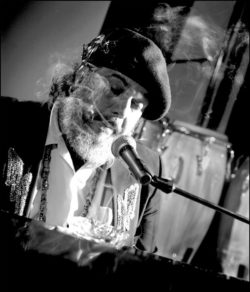Dr. John
Dr. John was an important New Orleans-born rhythm and blues singer, composer, and keyboardist.

HERMAN LEONARD
Dr. John, San Francisco, 1992.
Malcolm John “Mac” Rebennack Jr. was a musician, singer, and composer from New Orleans best known by the stage name “Dr. John.” He recorded and performed for close to five decades, drawing on a wide range of musical styles but remaining rooted in the traditions and idiosyncrasies of New Orleans. When segregation was at its height, he was one of the few white musicians to play a role in the city’s “golden age of rhythm and blues (R&B),” supporting legends like Huey “Piano” Smith, Allen Toussaint, and Earl King at venues including the famous Dew Drop Inn. His own recording life began in 1959, and from then he enjoyed a prolific career. Beginning in the late 1960s, his recording and stage persona of “Dr. John the Night Tripper” incorporated elements from New Orleans’s Voudou and carnival traditions into a mystical, shaman-like figure.
Early Years
Rebennack’s involvement with the New Orleans R&B scene began when he was a teenager. By age sixteen, he was playing guitar in Cosimo Matassa’s studio, backing up legends like Professor Longhair, Frankie Ford, and Joe Tex. He played with local bands, including Frankie Ford and the Thunderbirds, Jerry Byrne and the Loafers, and his own group, the Skyliners. His precocious abilities included a gift for songwriting, arranging, and producing; in 1958, he worked with Allen Toussaint on teen idol Jimmy Clanton’s “Just a Dream,” which topped the Billboard charts for more than four months. His credits also include writing and producing Johnny Adams’s breakthrough hit, “Losing Battle.” Under his own name, he enjoyed a regional hit with the guitar-driven instrumental “Storm Warning,” released in 1959 on Rex, a subsidiary of Ace Records.
The decade of the 1960s was a transformative period in Rebennack’s life and career. His guitar playing suffered a setback in 1960, when a portion of his left ring finger was shot off in a barroom gunfight, forcing a switch to keyboards as his primary instrument. In 1963, he was arrested on narcotics charges and served two years in prison. Upon release, he headed to Los Angeles, joining other New Orleans musical expatriates such as Alvin Robinson, Shirley Goodman, and Jesse Hill. Producer/arranger Harold Battiste helped him find work backing a variety of big-name artists, including soul acts like Sam Cooke and Aretha Franklin, pop stars Sonny and Cher, and blues rockers Canned Heat. He played on the Rolling Stones’ Exile on Main Street and John Lennon’s Rock ’n’ Roll.
Dr. John the Night Tripper
His solo career began in earnest in 1968, when he signed with Atco Records and released his first album, Gris-Gris. The record introduced the character of “Dr. John the Night Tripper,” a psychedelic take on New Orleans’s Voudou religious practices. The name “Dr. John” is a reference to a nineteenth-century Voudou practitioner who claimed to be descended from West African royalty. Rebennack developed a cult following for his wild performances, with their freak show overtones. Mystical, occult themes marked his subsequent releases for Atco, including Babylon (1969) and Remedies (1970). His 1971 album The Sun, Moon & Herbs featured guest appearances by Mick Jagger and Eric Clapton.
Rebennack moved to a more straightforward engagement with his New Orleans R&B roots on his fifth album, Gumbo (1972), which featured Crescent City standards by Archibald, Professor Longhair, and Earl King, and only one original composition. His next album, In the Right Place (1973), was produced by Allen Toussaint and featured backing music by The Meters. It included the song “Right Place, Wrong Time,” which has been his biggest hit to date. He continued to explore the possibilities of New Orleans funk on his 1974 album, Desitively Bonnaroo.
Recent Work
While his recorded output since the mid-1970s was eclectic and diverse (including albums of pop standards like 1989’s In a Sentimental Mood), he frequently returned to New Orleans-inspired material on releases such as Television (1994), Anutha Zone (1998), Creole Moon (2001), and N’Awlinz: Dis Dat or d’Udda (2004). In addition to his releases as a soloist, he performed and recorded with a wide range of artists from New Orleans and elsewhere, including the Rolling Stones, Neil Diamond, and Paul Simon. In 1979, he contributed guitar and production work to Professor Longhair’s last album, Crawfish Fiesta. More recently, he released several “tribute” albums, including Duke Elegant in 2000 and Mercernary in 2006, spotlighting the songwriting of Duke Ellington and Johnny Mercer, respectively. His autobiography, Under a Hoodoo Moon, was published in 1994. His gruff voice and down-home presentation have become icons of New Orleans’s distinctive cultural identity: He recorded jingles for the Popeyes Chicken franchise, as well as the theme song for the Disney movie The Princess and the Frog, set in old New Orleans. He was inducted into the Louisiana Music Hall of Fame in 2008.
Though he lived primarily in New York and Long Island for the last several decades of his life, Rebennack remained connected to the people, culture, and music of his hometown, raising issues of social and environmental justice in his music. He responded to the Hurricane Katrina disaster with the seven-song benefit extended play, Sippiana Hericane. His 2008 album City That Care Forgot (released on 429 Records) reflected Rebennack’s anger and frustration at the state of his hometown three years after the disaster. In addition to his backing band, the Lower 911, the album (which won a Grammy for Best Contemporary Blues Album) included high-profile guest appearances by Eric Clapton, Willie Nelson, Ani DiFranco, and Terence Blanchard. Five of the songs were written in collaboration with Bobby Charles, the south Louisiana songwriter and performer who penned “Walking to New Orleans” for Fats Domino, among other hits. Dr. John died on June 6, 2019, at the age of 77.
